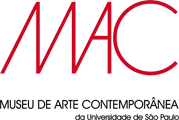Coleção Fulvia e Adolpho Leirner do Art Déco Brasileiro
[english]
O MAC USP entrou para a história das instituições artísticas no Brasil por ser pioneiro no colecionismo de novas tendências das artes visuais, através da reunião de um conjunto formidável de obras e proposições de arte conceitual.
Fala-se menos na ação permanente do Museu em colecionar e investigar a história da arte da primeira metade do século 20, mas que foi por ele empreendida desde sua primeira década de existência, através da aquisição de obras de artistas até então não considerados na narrativa da arte moderna, e para além dos suportes mais tradicionais das artes visuais. Este foi o caso da compra de 18 estudos de estamparia de Antônio Gomide por ocasião da primeira exposição retrospectiva do artista em um espaço institucional, em 1969, assim como de projetos para murais e outros objetos de artes gráficas e das ditas artes aplicadas, de autoria de Fulvio Pennacchi e Mario Zanini, por exemplo. Essas iniciativas reconheciam a importância de se considerar essa dimensão mais ampla do projeto modernista, que também se fazia refletir na própria coleção que o MAC USP herdou do MAM São Paulo, na sua criação em 1963. Em grande medida angariada por via das edições da Bienal de São Paulo, na década de 1950, a coleção de arte moderna do MAC USP já possuía alguns objetos e obras de seções do evento dedicadas às artes do espetáculo, artes gráficas e artes decorativas.
A Coleção Fulvia e Adolpho Leirner do Art Déco Brasileiro, doada pelos colecionadores no final de 2020 ao MAC USP, veio a enriquecer e iluminar ainda mais o acervo existente e a pesquisa sobre a história das artes visuais na primeira metade do século 20 em desenvolvimento na instituição. Ela é um conjunto único de obras realizadas para o “viver moderno”, tão apreciado pela elite modernista de São Paulo, bem como reveladora dos modos de circulação das formas modernas entre nós. Alguns dos objetos agora recebidos pelo Museu complementam outras tantas obras nele presentes - a exemplo das obras da família Gomide-Graz e das cadeiras de Flávio de Carvalho. Vale por fim destacar o mobiliário que o arquiteto lituano Gregori Warchavchik concebeu para sua Casa Modernista, em 1930.
Ana Magalhães
Diretora MAC USP
Fulvia and Adolpho Leirner Collection of Brazilian Art Déco
[português]
MAC USP entered the history of artistic institutions in Brazil for pioneering the collection of new trends in the visual arts, through the gathering of a formidable set of works and propositions of conceptual art.
It is less commented MAC USP’s permanent action in collecting and investigating the history of art of the first half of the 20th century, even if the Museum did so since its first decade of existence through the acquisition of works by artists not considered in the narrative of modern art, and beyond the more traditional supports of the visual arts. This was the case of the purchase of 18 stamping studies by Antônio Gomide on the occasion of the artist’s first retrospective exhibition in an institutional environment in 1969, as well as the purchase of projects for murals and other objects of graphic arts and the so-called applied arts authored by Fulvio Pennacchi and Mario Zanini, for example. These initiatives recognized the importance of considering this broader dimension of the modernist project, which was also reflected in the very collection that MAC USP inherited from MAM when it was founded in 1963. Largely raised through the editions of the São Paulo Biennial of Art in the 1950s, the MAC USP’s modern art collection already had some objects and works from sections of the event dedicated to the arts of spectacle, graphic arts and decorative arts.
The Fulvia and Adolpho Leirner Collection of Brazilian Art Déco, donated by the collectors at the end of 2020 to MAC USP, came to enrich and further illuminate the existing collection and research on the history of visual arts from the first half of the 20th century under constant development in the institution. This collection is a unique set of works made for the “modern living”, which was so appreciated by the modernist elite of São Paulo, as well as revealing of the modes of circulation of modern forms among us. Some of the objects now received by the Museum complement many other pieces already present in it – such as the works by the Gomide-Graz family and the chairs by Flávio de Carvalho. Finally, it is worth mentioning the furniture that Lithuanian architect Gregori Warchavchik designed for his Modernist House in 1930.
Ana Magalhães
Director MAC USP
© 2021 - Museu de Arte Contemporânea da Universidade de São Paulo


